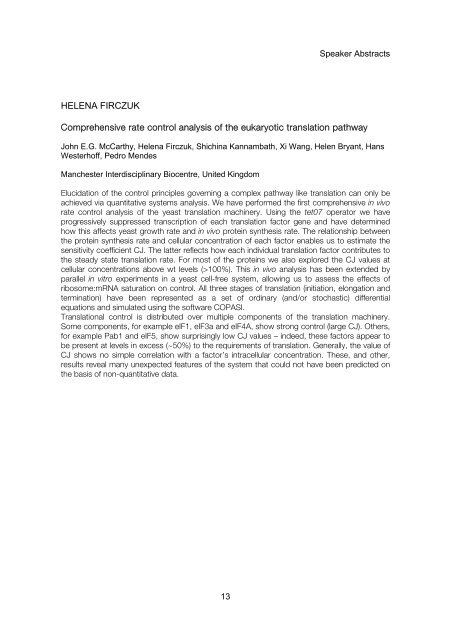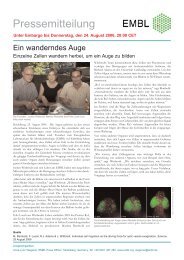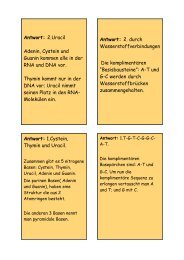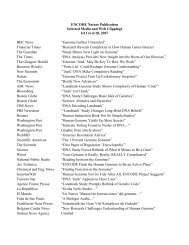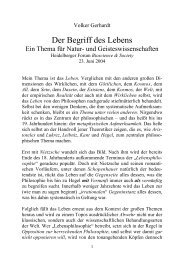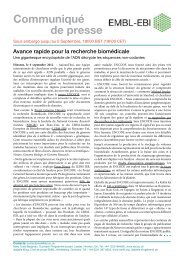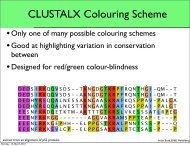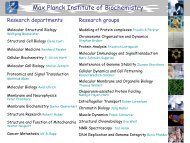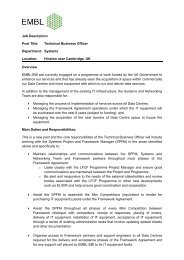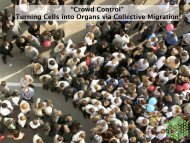EMBO Conference on Protein Synthesis and Translational Control
EMBO Conference on Protein Synthesis and Translational Control
EMBO Conference on Protein Synthesis and Translational Control
Create successful ePaper yourself
Turn your PDF publications into a flip-book with our unique Google optimized e-Paper software.
HELENA FIRCZUK<br />
13<br />
Speaker Abstracts<br />
Comprehensive rate c<strong>on</strong>trol analysis of the eukaryotic translati<strong>on</strong> pathway<br />
John E.G. McCarthy, Helena Firczuk, Shichina Kannambath, Xi Wang, Helen Bryant, Hans<br />
Westerhoff, Pedro Mendes<br />
Manchester Interdisciplinary Biocentre, United Kingdom<br />
Elucidati<strong>on</strong> of the c<strong>on</strong>trol principles governing a complex pathway like translati<strong>on</strong> can <strong>on</strong>ly be<br />
achieved via quantitative systems analysis. We have performed the first comprehensive in vivo<br />
rate c<strong>on</strong>trol analysis of the yeast translati<strong>on</strong> machinery. Using the tet07 operator we have<br />
progressively suppressed transcripti<strong>on</strong> of each translati<strong>on</strong> factor gene <strong>and</strong> have determined<br />
how this affects yeast growth rate <strong>and</strong> in vivo protein synthesis rate. The relati<strong>on</strong>ship between<br />
the protein synthesis rate <strong>and</strong> cellular c<strong>on</strong>centrati<strong>on</strong> of each factor enables us to estimate the<br />
sensitivity coefficient CJ. The latter reflects how each individual translati<strong>on</strong> factor c<strong>on</strong>tributes to<br />
the steady state translati<strong>on</strong> rate. For most of the proteins we also explored the CJ values at<br />
cellular c<strong>on</strong>centrati<strong>on</strong>s above wt levels (>100%). This in vivo analysis has been extended by<br />
parallel in vitro experiments in a yeast cell-free system, allowing us to assess the effects of<br />
ribosome:mRNA saturati<strong>on</strong> <strong>on</strong> c<strong>on</strong>trol. All three stages of translati<strong>on</strong> (initiati<strong>on</strong>, el<strong>on</strong>gati<strong>on</strong> <strong>and</strong><br />
terminati<strong>on</strong>) have been represented as a set of ordinary (<strong>and</strong>/or stochastic) differential<br />
equati<strong>on</strong>s <strong>and</strong> simulated using the software COPASI.<br />
Translati<strong>on</strong>al c<strong>on</strong>trol is distributed over multiple comp<strong>on</strong>ents of the translati<strong>on</strong> machinery.<br />
Some comp<strong>on</strong>ents, for example eIF1, eIF3a <strong>and</strong> eIF4A, show str<strong>on</strong>g c<strong>on</strong>trol (large CJ). Others,<br />
for example Pab1 <strong>and</strong> eIF5, show surprisingly low CJ values – indeed, these factors appear to<br />
be present at levels in excess (~50%) to the requirements of translati<strong>on</strong>. Generally, the value of<br />
CJ shows no simple correlati<strong>on</strong> with a factor’s intracellular c<strong>on</strong>centrati<strong>on</strong>. These, <strong>and</strong> other,<br />
results reveal many unexpected features of the system that could not have been predicted <strong>on</strong><br />
the basis of n<strong>on</strong>-quantitative data.


